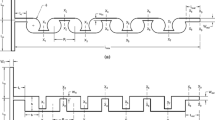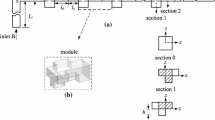Abstract
In this paper, both numerical simulation and experiment were performed to investigate the mixing process within mixing chambers of the planar micromixer with three baffles at varied baffle height. The presence of three baffles causes the flow to separate and creates the recirculation and back flow within mixing chambers. The fluid mixing was greatly influenced by the baffle height and Reynolds number (Re) related to the size of recirculation zone. Larger baffle height or Re produces larger recirculation zone and convective mixing. The micromixer with 350 μm high baffles in 400 μm wide channel results in over 95% mixing at Re = 80 from the simulation results. The experiment results confirm the above simulation results qualitatively. This planar micromixer has the merits of simple design and easy fabrication as compared to the three-dimensional passive micromixers.









Similar content being viewed by others
References
Bau HH, Zhong J, Yi M (2001) A minute magneto hydro dynamic (MHD) mixer. Sens Actuators B Chem 79:207–215
Bhaqat A, Peterson ET, Papautky L (2006) Passive micromixer with break-up obstructions. In: Proceedings of SPIE Microfluidics, BioMEMS, and Medical Microsystems Conference, SPIE 6112, 61120J
Bhaqat AS, Daqani G, Peterson ETK, Papautky L (2005) Passive micromixer with obstructions for Lab-on-a-chip applications. In: Proceedings of SPIE Microfluidics, BioMEMS, and Medical Microsystems Conference, SPIE 5718, pp 291–297
Bökenkamp D, Desai A, Yang X, Tai YC, Marzluff EM, Mayo SL (1998) Microfabricated silicon mixers for submillisecond quench-flow analysis. Anal Chem 70:232–236
Cha J, Kim J, Ryu SK, Park J, Jeong Y, Park S, Park S, Kim HC, Chun K (2006) A highly efficient 3D micromixer using soft PDMS bonding. J Micromech Microeng 16:1778–1782
Engler M, Föll C, Kockmann N, Woias P (2003) Investigations of liquid mixing in static micro mixers. In: Proceedings of the 11th European Conference on Mixing, pp 277–284
Hardt S, Drese KS, Hessel V, Schőnfeld F (2005) Passive micromixers for applications in the microreactor and μTAS fields. Microfluid Nanofluid 1:108–118
Kockmann N, Föll C, Woias P (2003) Flow regimes and mass transfer characteristics in static micro mixers. In: Proceedings of the SPIE Photonics West, micromachining and microfabrication, SPIE 4982, pp 319–329
Lee S, Lee HY, Lee IF, Tseng CY (2004) Ink diffusion in water. Eur J Phys 25:331–336
Liu RH, Stremler MA, Sharp KV, Olsen MG, Santiago JG, Adrian RJ, Aref H, Beebe DJ (2001) Passive mixing in three-dimensional serpentine microchannel. J Microelectromech Syst 19:190–196
Lu LH, Ryu KS, Liu C (2002) A magnetic microstirrer and array for microfluidic mixing. J Microelectromech Syst 11:462–469
Mengeaud V, Josserand J, Girault HH (2002) Mixing processes in a zigzag microchannel: finite element simulations and optical study. Anal Chem 74:4279–4286
Mousavi SS, Hooman K (2006) Heat and fluid flow in entrance region of a channel with staggered baffles. Energy Conv Manag 47:2011–2019
Nguyen NT, Wu Z (2005) Micromixers—a review. J Micromech Microeng 15:R1–R16
Santos NB, Lemos MJS De (2006) Flow and heat transfer in a parallel plate channel with porous and solid baffles. Numer Heat Tranf A-Appl 49:471–494
Vivek V, Zeng Y, Kim ES (2000) Novel acoustic-wave micromixer. In: Proceedings of the IEEE 13th International Conference on Micro Electro Mechanical Systems (MEMS), pp 668–673
Wang H, Lovenitti P, Masood S (2002) Optimizing layout of obstacles for enhanced mixing in microchannels. Smart Mater Struct 11:662–667
Xia HM, Wan SYM, Shu C, Chew YT (2005) Chaotic micromixers using two-layer crossing channels to exhibit fast mixing at low Reynolds numbers. Lab Chip 5:748–755
Yamaguchi Y, Ogino K, Yamashita K, Maeda H (2004) Rapid micromixing based on multilayer laminar flows. J Chem Eng Jpn 37:1265–1270
Acknowledgments
This work is partial sponsored by National Science Council (NSC) under contract No NSC 94-2212-E-006-055. We pay our great thanks to the Center for Micro/Nano Science and Technology (CMNST) in National Cheng Kung University for the access of process and analysis equipments. We would also like to thank National Center for High-performing Computing (NCHC) for providing a computational fluid dynamics software in this work.
Author information
Authors and Affiliations
Corresponding author
Rights and permissions
About this article
Cite this article
Chung, C.K., Wu, CY. & Shih, T.R. Effect of baffle height and Reynolds number on fluid mixing. Microsyst Technol 14, 1317–1323 (2008). https://doi.org/10.1007/s00542-007-0511-1
Received:
Accepted:
Published:
Issue Date:
DOI: https://doi.org/10.1007/s00542-007-0511-1




